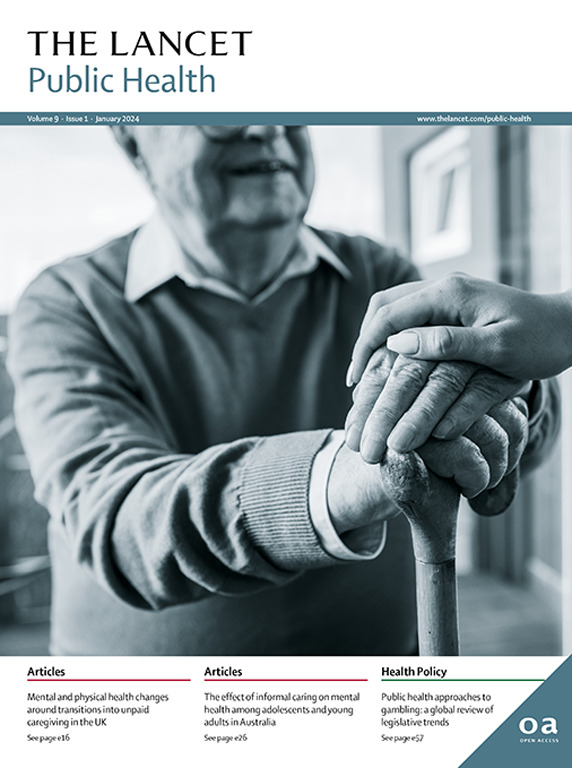The epidemiology and burden of ten mental disorders in countries of the Association of Southeast Asian Nations (ASEAN), 1990–2021: findings from the Global Burden of Disease Study 2021
IF 25.4
1区 医学
Q1 PUBLIC, ENVIRONMENTAL & OCCUPATIONAL HEALTH
引用次数: 0
Abstract
Background
The Association of Southeast Asian Nations (ASEAN), a geopolitical and economic network of ten member states, recognises mental disorders as a health priority; however, sparse epidemiological data hinder the development of effective strategies to reduce their prevalence and burden. We aimed to examine the prevalence, morbidity, and disease burden associated with ten mental disorders from 1990 to 2021 in the ASEAN.Methods
As part of the Global Burden of Diseases, Injuries, and Risk Factors Study (GBD 2021), we analysed estimates for depressive disorders, anxiety disorders, bipolar disorders, schizophrenia, autism spectrum disorders, conduct disorder, attention-deficit hyperactivity disorder (ADHD), eating disorders, idiopathic developmental intellectual disability, and other mental disorders in ten ASEAN member states (Brunei, Cambodia, Indonesia, Laos, Malaysia, Myanmar, the Philippines, Singapore, Thailand, and Viet Nam). Case definitions were based on Diagnostic and Statistical Manual of Mental Disorders or ICD criteria. Prevalence estimates by age, sex, year, and location were derived using DisMod-MR 2.1, a Bayesian meta-regression modelling tool. Disease burden was quantified by estimating years lived with disability (YLDs), years of life lost (YLLs), and disability-adjusted life-years (DALYs). Estimates are presented with 95% uncertainty intervals (UIs).Findings
In 2021, 80·4 million (95% UI 73·8–87·2) cases of mental disorders were reported across ASEAN countries, representing a 70·0% (63·5–77·2) increase since 1990. The age-standardised prevalence of mental disorders was 11·9% (10·9–12·9) in 2021, ranging from 10·1% (9·1–11·3) in Viet Nam to 13·2% (11·6–15·3) in Malaysia, with anxiety and depressive disorders being the most common. The age-standardised prevalence of mental disorders increased by 6·5% (3·7–9·8) between 1990 and 2021. Mental disorders accounted for 11·2 million (8·5–14·3) DALYs in 2021, representing an 87·4% (81·1–94·0) increase since 1990. The 10–14 years age group had the highest disease burden attributable to mental disorders, which accounted for 16·3% (12·7–20·5) of total DALYs in this age group. The largest relative increases in the number of cases of mental disorders between 1990 and 2021 were seen in older adults (182·8% [174·9–192·1] among those aged ≥70 years), despite small relative changes in prevalence in these age groups.Interpretation
The increase in mental disorder prevalence and burden found in this study might partly reflect recent improvements in detection. However, mental disorders now rank among the top ten causes of disease burden in all ASEAN countries except Myanmar, underscoring the urgent need for a comprehensive intersectoral approach to address prevention and treatment gaps across entire populations.Funding
Gates Foundation.1990-2021年东南亚国家联盟(东盟)国家十种精神障碍的流行病学和负担:《2021年全球疾病负担研究》的结果
东南亚国家联盟(东盟)是一个由十个成员国组成的地缘政治和经济网络,它承认精神障碍是一个卫生优先事项;然而,稀疏的流行病学数据阻碍了制定有效战略以减少其流行和负担。我们的目的是研究1990年至2021年东盟10种精神障碍的患病率、发病率和疾病负担。作为全球疾病、伤害和风险因素负担研究(GBD 2021)的一部分,我们分析了10个东盟成员国(文莱、柬埔寨、印度尼西亚、老挝、马来西亚、缅甸、菲律宾、新加坡、泰国、泰国和泰国)的抑郁症、焦虑症、双相情感障碍、精神分裂症、自闭症谱系障碍、行为障碍、注意力缺陷多动障碍(ADHD)、饮食障碍、特发性发育性智力障碍和其他精神障碍的估计数据。泰国和越南)。病例定义基于精神障碍诊断与统计手册或ICD标准。使用dismod - mr2.1(一种贝叶斯元回归建模工具)得出年龄、性别、年份和地点的患病率估计。通过估算残疾生活年数(YLDs)、生命损失年数(YLLs)和残疾调整生命年(DALYs)来量化疾病负担。估计以95%的不确定区间(UIs)表示。2021年,东盟国家报告了8040万例精神障碍病例(95%为73.8 - 87.2),自1990年以来增加了70%(63.5 - 77.2)。2021年,精神障碍的年龄标准化患病率为11.9%(10.9 - 12.9),从越南的10.1%(9.1 - 11.3)到马来西亚的13.2%(11.6 - 15.3),其中焦虑和抑郁症是最常见的。1990年至2021年间,精神障碍的年龄标准化患病率增加了6.5%(3.7 - 9.8%)。2021年,精神障碍占1120万(8.5 - 14.3)个残疾调整生命年,自1990年以来增加了84.7%(81.1 - 99.4)。10-14岁年龄组因精神障碍引起的疾病负担最高,占该年龄组DALYs总数的16.3%(12.7 - 20.5%)。1990年至2021年期间,精神障碍病例数的相对增幅最大的是老年人(年龄≥70岁者中占182·8%[174·9-192·1]),尽管这些年龄组的患病率相对变化较小。本研究中发现的精神障碍患病率和负担的增加可能部分反映了最近检测的改进。然而,在除缅甸以外的所有东盟国家,精神障碍现在都是造成疾病负担的十大原因之一,这突出表明迫切需要采取全面的部门间办法,以解决整个人口的预防和治疗差距。FundingGates基础。
本文章由计算机程序翻译,如有差异,请以英文原文为准。
求助全文
约1分钟内获得全文
求助全文
来源期刊

Lancet Public Health
Medicine-Public Health, Environmental and Occupational Health
CiteScore
55.60
自引率
0.80%
发文量
305
审稿时长
8 weeks
期刊介绍:
The Lancet Public Health is committed to tackling the most pressing issues across all aspects of public health. We have a strong commitment to using science to improve health equity and social justice. In line with the values and vision of The Lancet, we take a broad and inclusive approach to public health and are interested in interdisciplinary research.
We publish a range of content types that can advance public health policies and outcomes. These include Articles, Review, Comment, and Correspondence. Learn more about the types of papers we publish.
 求助内容:
求助内容: 应助结果提醒方式:
应助结果提醒方式:


